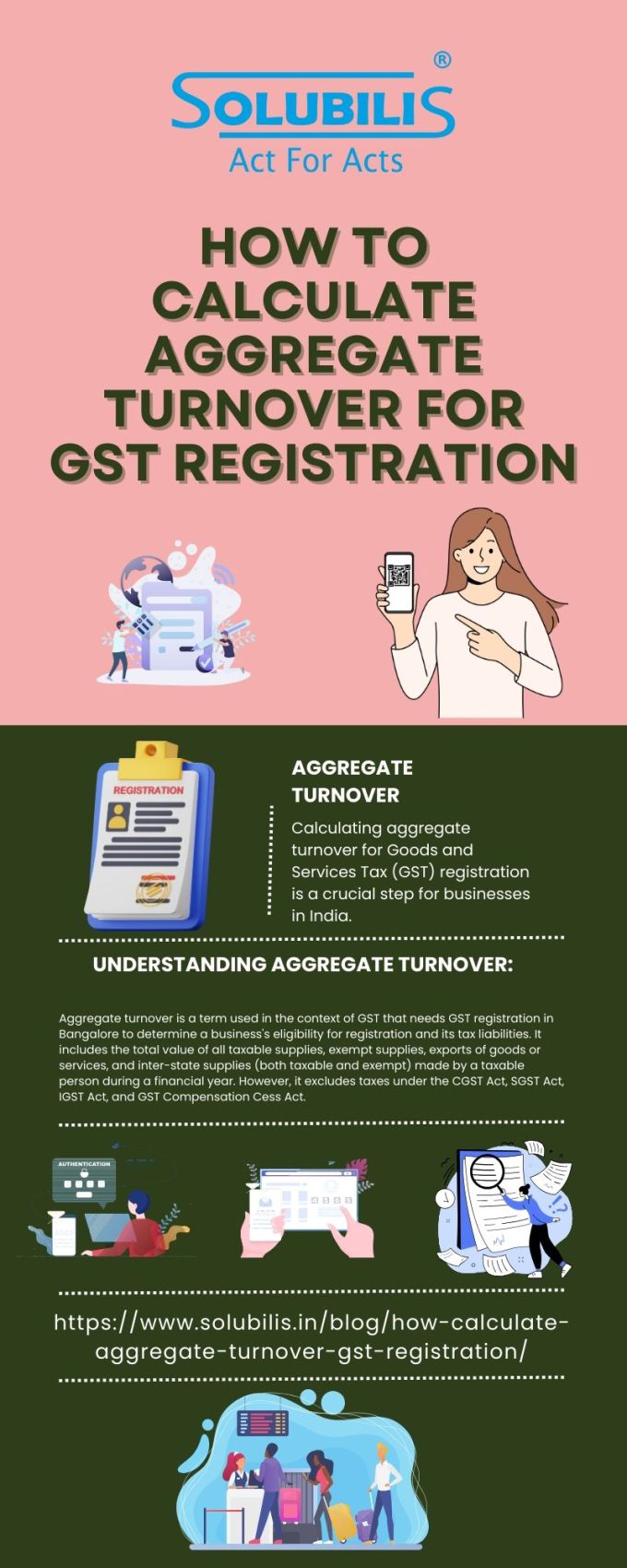How to calculate aggregate turnover for GST registration

Calculating aggregate turnover for Goods and Services Tax (GST) registration is a crucial step for businesses in India. Aggregate turnover determines whether a business is required to register under GST and what type of registration is applicable. In this blog, we will explain how to calculate aggregate turnover for GST registration and the key considerations involved.
Understanding Aggregate Turnover:
Aggregate turnover is a term used in the context of GST that needs GST registration in Bangalore to determine a business’s eligibility for registration and its tax liabilities. It includes the total value of all taxable supplies, exempt supplies, exports of goods or services, and inter-state supplies (both taxable and exempt) made by a taxable person during a financial year. However, it excludes taxes under the CGST Act, SGST Act, IGST Act, and GST Compensation Cess Act.
Components of Aggregate Turnover:
To calculate aggregate turnover accurately, you need to consider the following components:
a. Taxable Supplies: This includes all supplies of goods or services on which GST is levied at the applicable rates. It forms a significant part of the aggregate turnover.
b. Exempt Supplies: While exempt supplies themselves are not subject to GST, they must still be included in the aggregate turnover calculation. Examples of exempt supplies include certain agricultural products and healthcare services.
c. Export of Goods or Services: The value of exports of goods or services, including the Integrated Goods and Services Tax (IGST) portion, should be included in aggregate turnover.
d. Inter-State Supplies: Supplies made from one state to another, whether taxable or exempt, should be included.
e. Reverse Charge Mechanism: Supplies on which GST that has GST registration in Bangalore is payable under the reverse charge mechanism by the recipient should be added to the aggregate turnover.
f. Non-GST Supplies: Some supplies may not attract GST, such as alcohol for human consumption. While not part of the GST liability, they are included in the aggregate turnover.
g. Job Work: The value of goods or services sent for job work, along with the consideration for such job work, should be considered.
h. Excluded Items: Certain items like discounts, subsidies, and advances received for supply of goods or services that are adjusted against the final invoice are not included in the aggregate turnover.
i. Taxes, Cess, and Duties: Central Excise duty, State VAT, and other taxes, cess, and duties that have subsumption by GST which has GST registration in Bangalore are not part of the aggregate turnover.
Annual Threshold Limit for Registration:
One of the key factors in determining whether a business requires to register under GST is the annual threshold limit. As of my knowledge cut-off date in September 2021, the threshold limit for GST registration varied for different categories of taxpayers:
For businesses operating in most states: The threshold limit was Rs. 20 lakhs (Rs. 10 lakhs for special category states).
For service providers: The threshold limit was Rs. 20 lakhs (Rs. 10 lakhs for special category states).
For casual taxable persons and non-resident taxable persons: The threshold limit was Rs. 20 lakhs.
For persons engaged in the supply of goods through e-commerce operators: The threshold limit was Rs. 20 lakhs (Rs. 10 lakhs for special category states).

How to Calculate Aggregate Turnover:
To calculate your aggregate turnover for GST registration, follow these steps:
Identify All Revenue Streams:
Start by identifying all the revenue streams of your business. This includes the value of all taxable and exempt supplies, export sales, inter-state sales, job work transactions, and supplies subject to reverse charge.
Exclude Non-GST Supplies:
Exclude any revenue generated from non-GST supplies, such as alcohol for human consumption, from your calculation.
Include IGST on Exports:
For export sales, remember to include the IGST component in the turnover calculation.
Determine Threshold Limit:
Check the current GST threshold limit applicable to your category of business and your state. If your aggregate turnover exceeds this threshold, you are liable to register under GST.
Regularly Monitor Turnover:
It’s essential to monitor your turnover continuously throughout the financial year, as you may cross the threshold at any time. If your aggregate turnover exceeds the threshold, you need to apply for GST that has GST registration in Bangalore within 30 days from the date when you became liable to register.
Examples of Aggregate Turnover Calculation:
To illustrate the calculation of aggregate turnover, consider the following examples:
Example 1: Sole Proprietor Selling Goods
Let’s say a sole proprietor operates a retail store in a non-special category state and sells taxable goods worth Rs. 15 lakhs, exempted goods worth Rs. 2 lakhs, and exports goods worth Rs. 3 lakhs during a financial year. In this case, the aggregate turnover is:
Total Turnover = Taxable Goods + Exempted Goods + Export of Goods Total Turnover = Rs. 15 lakhs + Rs. 2 lakhs + Rs. 3 lakhs Total Turnover = Rs. 20 lakhs
Since the aggregate turnover exceeds the threshold limit of Rs. 20 lakhs for most states, the sole proprietor is liable to register for GST.
Example 2: Service Provider
Consider a freelance graphic designer providing services worth Rs. 8 lakhs during a financial year. In this case, the aggregate turnover is:
Total Turnover = Value of Services Total Turnover = Rs. 8 lakhs
Since the aggregate turnover is below the threshold limit of Rs. 20 lakhs for service providers in most states, GST registration in Bangalore is not mandatory in this scenario.
Regular GST Return Filing:
Once registered under GST, businesses should file regular GST returns, including GSTR-1 (outward supplies), GSTR-3B (summary return), and GSTR-9 (annual return). The frequency of return filing depends on the type of taxpayer and the turnover. Non-compliance with return filing and payment of taxes may lead to penalties and legal consequences.
Conclusion:
Calculating aggregate turnover for GST registration in Bangalore is a crucial step for businesses in India. It determines whether a business requires to register under GST, and it influences the type of registration required.
Accurate calculation and monitoring of aggregate turnover are essential to ensure compliance with GST laws and regulations. It’s important to stay updated with the latest GST rules and threshold limits, as they may change over time, and consulting with a qualified tax professional is advisable for proper guidance in GST compliance.

